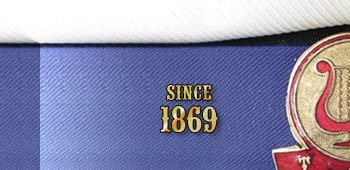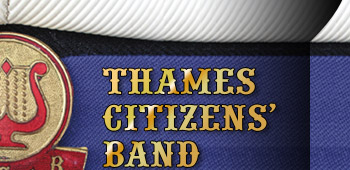THE FOUR NAMES OF THAMES CITIZENS’ BAND:
All References in [ ]
CHAPTER 4. OUR THIRD NAME: ’THE 6TH HAURAKI REGIMENTAL BAND’ (1909 – 1941)
4.a. The Government rolls Volunteers and conscription into NZ Territorials then the Settlers Reunite.
The NZ Defence Act 1909 changed all the Volunteer Forces into the national N.Z. Territorial Force (which included compulsory military training for males aged 12 to 25 – or conscription). The former No 2 ’Hauraki’ Battalion of Auckland District was reorganised and renamed the 6th Hauraki Regiment of the N.Z. Territorial Force, Auckland District, and with it the No 2 ’Hauraki’ Battalion Band was also renamed the 6th Hauraki Regimental Band as a matter of course. In 1913 after so many changes Thames remembered its own with its “Old Thames Settlers Reunion.” It proved a hit with a 1000 people arriving by the Steamer “Wakatere” alone from Auckland for the occasion. The town was a-buzz with events including the ex-Naval Band performing now as the 6th Hauraki Regimental Band all around the towns public areas. [140] [Pic 11]
PIC 11 Old Thames Settlers Reunion – Victoria Park (1913)
4.b. Movies, The Great War and another flood.
A huge change for the entertainment industry of Thames and the nation (even the world) was the invention of moving pictures - “pictures” or “movies.” Thames first advertised pictures in 1911 were under the names: “Haywards Pictures” and “Roberts Pictures.” This was before the big performance theatres in the town at the time picked up showing these “pictures” on screens in front of their respective stages over the following decade. These “Movies” were also in competition with the 2 main roller skating rinks at the time and would eventually grow in popularity and, along with dwindling population numbers, closed some of these roller skating rinks down. [182, 198] But the band played on! In 1914 war was declared on Germany and NZ naturally pledged to back England. Volunteers from the 6th Hauraki Regiment were made into a company of the N.Z. Expeditionary Force that went overseas to fight in World War I (WWI) and the band was kept busy playing for these volunteers as they left for their “tour of duty” from Thames’ wharfs and train stations. [43, 92, 199] The 6th Hauraki Regiment continued with its Headquarters in Paeroa, while the Regimental Band remained in Thames practising in their new Drill Hall on Mackay Street after it was completed in 1915 (now Murphys Bus depot (2011)) [Pic 12]. [40,41, 92] At the end of 1915 the band also performed in novel entertainment with the first electric lights at the Victoria Park Band Rotunda to a bedazzled crowd. [92] Near the start of 1917 parts of Thames were ravaged by another devastating flood, the Hospital was seriously effected this time. [200]
PIC 12 Old Drill Shed – Murphys Bus Depot (2011)
4.c. The first ANZAC Day, Paddys Market Parade & Motor cars.
The 6th Hauraki Regimental Band often performed at the Victoria Park Band Rotunda and on 8 February in 1917, despite the recent flood, they played: “Queen of the North” (a march), “Tasma” (a selection), “In Rag Town” (a cake walk), “Kai Ora” (a march), “Gold and Silver” (a waltz), “In Morrocco” (a Moorish serenade), “Twilight Shadows” (a serenade), “Faithful Lovers” (a waltz), “Colonel Bogey” (a march) and “God Save the King.” [70] In 1916, on April 25, Thames’ first ANZAC day service was held in the Thames Central Hall, and then again in 1917 at the Kings Theatre with the 30 strong Regimental Band leading the way. On this occasion the Regimental Band played the following: “Trumphant” (Chopin) (funeral march), “Recessional” (Kipling) (Hymn), “The Nameless Graves” (John Oxenham) (Hymn), “The Dead March in Saul” (funeral march), “O God Our Help in Ages Past” (Hymn) and “God Save the King.” These ANZAC day services would become a very heartfelt annual event for the Regimental Band and the citizens of Thames. [72, 75, 92] Another of the many firsts for this Band was at the end of that year. On December 3, the band led the first Paddy’s Market Procession down the main street of Thames - something few could realise at the time would later develop into the annual Thames Christmas Parade, for which the Thames Citizens’ Band still parades. [71]
Another new invention to bring enormous change to Thames, the nation, and the world was the Motor Car. They began to be sold in Thames for the first time in 1917. This was to push through changes to tar sealed roads, bridges and roads across the Hauraki Plains with its 3 rivers (The Waihou, Piako & Waitakaruru), disrupted sea and rail travel, and allowed people to go in their own time to performances and meetings across great distances. This made Thames a much smaller place. This effectively reconnected Thames and Auckland and gave people greater entertainment options in the now more accessible bigger city. [198, 201, 202]
4.d. Band Song, WW1 & Hauraki Brass Band end.
In April 1918 the Regimental Bands’ Bandmaster, Lieut. A. Clarke, released a song he had composed titled “Love’s Memories” (a ballad), described as “…being in a key for a medium range voice.” [73] Perhaps this was played by the regimental band that same year at the unveiling of the Roll of Honor, in Victoria Park, which commemorates the Regiment and those who died in the Boer War. [74] Then in November that year WWI ended and the band lead numerous processions along the main streets of Thames with much merriment all round. [93] The band was also there leading the military formation for the visit of the Governor General, Lord Liverpool, to Thames in 1919, while still performing for various social occasions around the district, for example at a dance in Kerepehi only two days prior to the Governor General’s visit. [76] Amidst the popularity of the 6th Hauraki Regimental Band the Hauraki Brass Band, which had effectively become the cadet band for the Regiment, played its last performance and put on a “Smoke” concert to celebrate in 1923. [84] A number of the players joined the Regiment Band when openings became available – especially the Williams brothers whose names had become synonymous with band music in the town. With this influx of new energetic talent the Regiment band won first prize in the Palmerston North Brass Band Contest the following year. [Pic 13]
PIC 13 – 6th Hauraki Regimental Band – First at Palmerston North Competition 1924
4.e. A new Bridge, A new Wharf – the Press disregard the band.
Although the promised civic ceremony to celebrate the driving of the first pile of the Hauraki Bridge (Kopu Bridge) in 1925 and also later at its completion in 1928 never happened, instead a government official made a quick speech and then people walked over it before cars started using it, the driving of the first pile for the main Thames Wharf (still standing today) in 1925 was celebrated in style with the speeches filling the pages of the Thames Star at the time; and although it was not mentioned, the Regimental band was there creating the much needed pomp and ceremony for the occasion. [95] This seemed to happen, disappointingly, with increasing regularity from this time on; the band would play, the public enjoy it, but the media had become blind to the band’s efforts and never reported it.
4.f. The Jubilee and end of conscription. Depression and the band changes hands.
The Thames Diamond (75th) Jubilee was celebrated for some reason in 1927, finally without war drowning some of the happiness, as had happened in the previous Golden (50th) Jubilee in 1917. [96] The Regimental Band was there leading the processions. In 1930 at a military ceremony in Paeroa the 6th Hauraki Regiment was presented their new colours, which were on a Royal Blue material, a similar colour to the current Thames Citizens’ Band uniform (2012). [44] Conscription was abolished in 1930 at the start of the Economic Depression and the Territorial Force dropped to just over a quarter of what it had been. Many officers were retired early without being replaced. [45] The army also tried to “starve” the Regimental Band financially in Thames through ’Retrenchment.’ This created an outcry and was the reason for a huge community meeting in October that year and Band Master Clarkes resignation. This was the beginning of the band becoming a civilian organization, with a committee being set up as a result of this meeting to run the band for the first time, This was to include three civilian members to help oversee this difficult transition time for the band. [97]
4.g. The Band is low.
The band’s morale was so low that the band came last in all of its B-Grade heats at the Brass Band Contest held at Rotorua in 1934. [120] [Pic 14] And the band’s financial situation was so bad that the run-down state of the band’s instruments was publicly commented on by one of the judges at the second Brass Band Competition held in Thames in 1938 - which had been organised by the band themselves along with the community of Thames. So that year (1938) the band purchased a new set of Besson brass Instruments with the help of intense community fundraising and a part loan from a finance company. Then the band tried many different businesses, community groups and fundraising efforts to pay off the loan but with the effects of the depression on everyone they could not sufficiently clear the debt on their instruments.
PIC 14 – Regimental band – Marching Rotorua Competition 1934
PREVIOUS CHAPTER | NEXT CHAPTER…
With New Membership...Every new Member gets a copy of "Thames Citizens’ Band - Past Present Future" valued at $5.00 FREE as part of their membership. |
FREE
|


